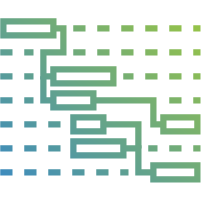Telemetry Dashboard
“If the metrics you are looking at are not useful in optimising your strategy, stop looking at them.” – Mark Twain
We want to bring value to companies
Our Telemetry Solution offers our customers a solution that enables deep insight into the efficiency of their software development, test processes and the software quality of their products. Based on real-time dashboards, our customers can monitor current trends at any time and specifically identify, introduce and continuously review improvement measures.
The foundation for this is a division of the metrics into team, department and IT-wide data that build on each other. As a result, it is quick and easy to start implementation with the teams who directly benefit from it. The solution will then be gradually expanded to include metrics for mid-level and senior management.
What is the best thing about it? We are not selling an expensive tool with high license costs. The technical solution is based on 100% open source tools and it is license-free; can be easily integrated into the existing IT landscape and expanded according to individual needs. The reason for this is that we want to bring a value to companies and not license costs.

To reach the top, you must start at the bottom
The theoretical foundation of our solution is our continuous delivery metrics tower. We have clustered the metrics in different stages, based on the stakeholders they are defined for. When implementing our solution, we always start at the bottom at team level, the reason for this is that the metrics in this stage are for the teams and only consists of raw data, which are directly steerable and processable. Normally we get this metrics from the continuous integration directly or from tools within the pipeline.

Based on the book Lean Analytics by Ben Yoskovitz, this is how we define good metrics
Stage 1 – Team Metrics
The team metrics are basic metrics, very close to the actual development and testing process; intend to give immediate feedback about the current state and trends so that the team can respond.
The metrics are easy to collect and to understand.
Stage 2 – Department Metrics
By adding defect-, bug tracking and requirements management information to the dashboard, and combining them with the already existing data, new metrics can be created. You will get insights on the overall quality of applications and how efficient the delivery and testing processes are running.
Stage 3 – Company Metrics
By adding data from operation tools and by aggregating metrics to provide further information, insights can be generated that are relevant for application owners, department heads and C-level management.

Comparative
Being able to compare a metric to other time periods, group of users or competitors helps you understand which way things are moving. “Increase conversion from last week” is better than “2% conversion.”

Understandable
If people cannot remember the numbers you are focused on and discuss them effectively, it is much harder to turn a change in the data into a change in the culture.

Rate or Ratio
Ratios and rates are inherently comparative. Accountants and financial analysts have several ratios they look at to understand the fundamental health of a company. You could benefit from some of this too.
Related Solutions



